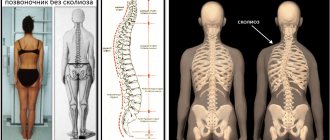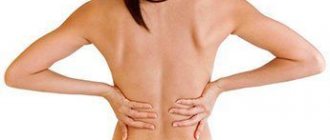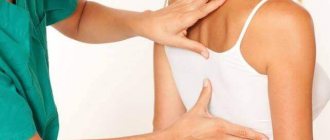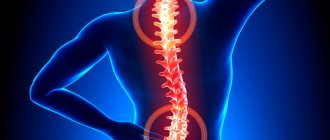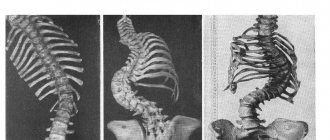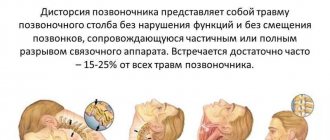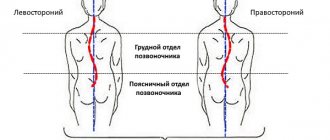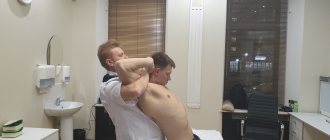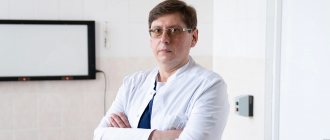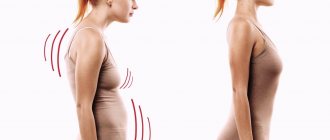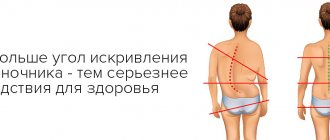Author
: Grachev Ilya Illarionovich
Editor
: Efremov Mikhail Mikhailovich
Date of publication: 09.10.2014 Date of update: 12.11.2020
A very common and rapidly developing disease of the spine is thoracic scoliosis, which is practically invisible at an early stage of development. Most often, this disease occurs in children and adolescents from 6 to 17 years old, with 80% of cases diagnosed in girls. This may be due to the fact that active elongation in growth occurs at this time.
A disease such as scoliosis is a curvature of the spine in which the vertebrae rotate around a central axis. This disease, without proper treatment, is dangerous because the twisting spine can over time compress or displace internal organs.
Causes of thoracic scoliosis
An inactive and sedentary lifestyle, rare physical activity are the main causes of thoracic scoliosis. Many people sit incorrectly at the computer, which leads to incorrect rotation of the body and further deformation of the spinal column. Other common causes of this disease:
- impaired muscle tone, weakening of ligaments;
- genetic disposition;
- received back injuries;
- asymmetrical leg length;
- asymmetrical sports also cause scoliosis - tennis, shot throwing, etc.;
- incorrect posture.
Symptoms to watch out for
- Backache. Stitching pain in the thoracic or lumbar spine. Outbreaks of pain are constant and often occur when sitting at a computer or game console for a long time.
- Slouching is a bent back as a result of weakness of the extensor muscles. If the muscle tissue is unable to hold the spine straight, it begins to bend.
- Chronic fatigue in the back. If fatigue does not go away after a massage or gymnastic exercises, contact a kinesiotherapist.
- Curvature of the position of the hips or shoulder blades. One leg is shorter than the other, one shoulder is higher, the other is lower - indicators of 2 or 3 degrees, depending on the level of difference.
- Constant pain in internal organs or limbs without visible injuries or causes is a reason to check the condition of the spine.
Symptoms of thoracic scoliosis
Good to know
- A set of exercise therapy exercises for scoliosis
- Massage for scoliosis
Fatigue, pain when sitting or standing are the main symptoms of thoracic scoliosis at the initial stage. Then visual changes appear: the pelvis is slightly skewed, the height of the shoulders turns out to be different, the waist is slightly asymmetrical. The higher the degree of the disease, the stronger and more dangerous the symptoms:
- noticeable distortion of the waist and cervical region in the second stage;
- weakening abdominal muscles, protruding anterior arches of the ribs in the third stage;
- at the fourth stage, the disease causes a rib hump, a significant deformation of the spine, and the functionality of the lungs and heart is impaired.
Degree of complexity of scoliosis
- First, the permissible level of deviation of the spine from a straight line to the right or left is 10 degrees. Considering the asymmetry of the body, this stage is not yet called a disease, but a number of exercises need to be applied to correct it. To diagnose the abnormality, visit an orthopedist and an x-ray office. The minimum tilt is not yet visible to the naked eye.
- The second is the deviation from the straight axis – 11-25 degrees. At this stage, an S-shaped curvature often develops. Along with the curvature of the upper part, changes begin in the pelvic area. Added to the change in shoulder level is the difference in hip levels. If you do not start rehabilitation at this stage, the disease will progress quickly.
- Third, the angle of inclination varies between 25 and 50 degrees. This slope causes deformation of internal organs, severe pain in the thoracic region and the spine itself. Respiratory function is impaired, and difficulties with mobility appear. It is difficult to cure the deviation without doctors, but constant and intense training will relieve pain and help build up lagging muscle mass.
- Fourth - the deviation from the axis exceeds 50 degrees. Movement causes severe pain; the person lies in bed all the time he is awake. This will require medical procedures and surgery, which can lead to deterioration in the flexibility of the spine. A fourth degree illness is equivalent to disability.
Treatment methods for thoracic scoliosis
It is necessary to begin complete and high-quality treatment of thoracic scoliosis in the early stages, while the disease can be cured quickly and without complications. This is exactly how experienced clinic specialists act. We select an individual complex for each patient, consisting of the following techniques:
- Acupuncture – affects biologically active points of the body, improves metabolic processes;
- Therapeutic acupressure – stimulates blood circulation and nutrition of spinal tissues, improves the functioning of internal organs;
- Soft manual techniques – eliminate scoliosis by relieving pain and excessive tension in the spinal muscles;
- A set of physical exercises strengthens the back muscles and prevents repeated curvature of the spine.
- Kinesiology, which involves pinpoint palpation on individual points to straighten the spine and consolidate the results of previous sessions;
- Hirudotherapy, used to relieve inflammation caused by changes in the shape of the spinal column;
- PRP therapy is the latest method of stimulating recovery processes. It is used to restore the functions of various organs after diseases and injuries, including to restore the function of the musculoskeletal system.
Treatment of scoliosis at the Paramita clinic
It is recognized that non-surgical methods are an effective way to combat the lesion. Everyone also knows that medications have many side effects. Certified doctors at our clinic use effective Eastern and Western methods for treating thoracic scoliosis.
Experienced doctors at the clinic will conduct the necessary diagnostic tests and select a comprehensive treatment for scoliosis, which will make you feel better literally after the first procedures. By contacting our clinic, you will see how effective an individual approach to each patient is.
Specifics of muscle strengthening and exercises for scoliosis
What is a muscle corset and why is it important?
Sign up for a free initial appointment
What it is
Scoliosis 4 degrees is a severe curvature of the spinal column , which is accompanied by impaired functioning of internal organs. Treatment of this pathology requires an integrated approach, including surgical intervention followed by a rehabilitation period. Scoliosis of the 4th degree cannot be treated conservatively.
Brief history of the disease
With scoliosis, the spine curves to the side. If the patient does not take measures to correct the situation, the disease progresses and the angle of curvature increases. Over time, malfunctions occur in the heart, stomach, lungs, intestines and other vital organs.
Pay attention to how the spine is curved with grade 4 scoliosis
Classification
Scoliosis grade 4 happens:
| C-shaped | Characterized by the presence of one scoliotic arch. |
| S-shaped | It involves a displacement of 2 sections of the spine and the formation of a pair of scoliotic arches. |
| Z-shaped | In this case, there is a more obvious arc of curvature and a sharp angle at the apex. |
Prevalence and significance
Grade 4 scoliosis is detected in 10% of patients who consult a doctor with complaints of spinal curvature. This pathology requires immediate treatment and long-term recovery, the task of which is to prevent the progression of the disease and an increase in the angle of deviation.
Diagnosis of thoracic scoliosis
The difference between Eastern diagnostic methods is in relation to the human body. If Western medicine strives to identify a disease, our specialists try to determine its cause and interaction with the body. Therefore, at the first stage of diagnosis you will be asked to:
- describe in as much detail as possible the history of the appearance of the first signs of the disease;
- undergo pulse diagnostics (determining the state of the body);
- tilt the body forward with your arms down - to determine the severity of the disease;
- undergo neurological tests.
In the future, to clarify the details and characteristics of the disease, its effect on the body, research is carried out using Western methods:
- Magnetic resonance imaging (MRI), which allows you to literally illuminate the human body and determine the condition of the skeleton and internal organs;
- An electrocardiogram (ECG) to assess the condition of the heart muscle is required in the third stage of breast scoliosis;
- Ultrasound examination (ultrasound) is a procedure that does not require lengthy preparation and reveals characteristic signs of spinal curvature (arch);
- Lab tests.
Treatment can only be prescribed when the doctor makes a specific diagnosis. Timely contact with a specialist will relieve the disease before health problems arise.
Risk factors, causes and consequences
In most cases, the exact cause of the development of grade 4 scoliosis cannot be established. Moreover, it has been noticed that women more often suffer from such curvature of the spine.
The most common causes of scoliosis include:
- congenital diseases of the musculoskeletal system, such as Klippel-Feil syndrome;
- metabolic disorders;
- malignant neoplasms of the spine;
- vertebral hypermobility;
- pathologies accompanied by damage to the nervous system and muscular system (for example, polio);
- connective tissue diseases;
- diseases of the central nervous system;
- traumatic injuries;
- age-related changes in bone tissue (degenerative);
- lack of calcium, metabolic disorders.
The chances of “getting” grade 4 scoliosis increase:
- in adolescence, when, with the rapid growth of the skeleton, muscle mass does not have time to form;
- in people with lower limbs of different lengths;
- in children and adults who play some musical instruments (accordion, violin) and engage in sports that develop one side of the muscles (badminton, archery);
- in patients who have undergone heart surgery;
- with a sedentary lifestyle, which causes weakening of the muscular corset of the back;
- in people who spend a long time in a crooked position (at a desk, desk, computer, etc.).
Scoliosis grade 4 has a detrimental effect on the condition of internal organs.
It can lead to the development of:
- cardiopulmonary failure;
- stomach ulcers;
- gastrointestinal disorders;
- diseases of the genitourinary system;
- cholecystitis;
- infertility, problems with bearing a fetus.
Prevention of thoracic scoliosis
To reduce the risk of the disease and prevent recurrences after treatment of thoracic scoliosis, you need to follow preventive measures.
- Be more physically active;
- When working sedentarily, do not stay in one position for a long time;
- Watch your posture;
- Travel on foot more often;
- Engage in water sports, swimming;
- Take a massage course every six months;
- Evenly distribute the load on the spine;
- Organize a comfortable place to sleep.
Particular attention should be paid to prevention before the age of 17, supplemented by periodic examination by a specialist.
Progressive course of the disease
Unfortunately, a significant proportion of patients experience progression of the disease, even with proper conservative treatment. Up to 80% of cases of the disease are idiopathic scoliosis, its cause is unknown, and an unknown cause cannot be eliminated. Idiopathic scoliosis has a progressive course.
In such a situation, the patient’s discipline plays a big role, but many of them are simply not ready to wear the Chenault corset for 20 hours a day and do daily therapeutic exercises.
Percentage risk of scoliosis progression
Proper nutrition for scoliosis
Consumption of foods necessary for the formation of bone tissue and muscle nutrition helps both for prevention and in case of detected disease. The diet for thoracic scoliosis should include:
- Fresh fruits and vegetables, rich in microelements and vitamins;
- Peanuts, beans, peas, cottage cheese, meat - products containing proteins;
- Fish, chicken eggs, dairy products containing vitamin D;
- Nuts, dried fruits, spinach, sea buckthorn, sorrel, oatmeal (vitamin E);
- Seafood;
- Add various cereals to your diet.
Changing the diet for scoliosis is one of the components of complex treatment and prevention of the disease.
Exercise therapy for thoracic scoliosis
Exercise therapy or physical therapy for thoracic scoliosis of the spine is a set of exercises for recovery after treatment and prevention of the disease. Classes are conducted only if there are no contraindications. Exercises include:
- While lying on your back, alternately bend and straighten your legs at the knee. Perform up to 5 times;
- Lying on your back, bend your knees and arch your chest. Executes up to 4 times;
- Lying on your stomach and stretching your arms along your body, inhale and raise your legs and torso, focusing on your arms. Executes 4 times;
- Lying on your side, in the direction of which the curvature occurred, put your hands behind your head and inhale, then smoothly lower them, exhaling. Repeated slowly 4 times;
- Lying on your back, bend your knees and lift your pelvis up, bending in the thoracic area. Repeat smoothly up to 4 times.
Do not start exercises without consulting your doctor, it can cause serious harm! The specialist at our clinic treating you will develop a complex individually for you.
Treatment
Treatment of grade 4 scoliosis is necessary for:
- strengthening the ligaments and muscles of the spine;
- stabilization of the functioning of organs that have suffered as a result of curvature;
- reducing the deflection angle.
Drugs
Did you know that...
Next fact
Drug treatment for grade 4 scoliosis is not practiced.
Surgery
The most effective method of treating grade 4 scoliosis is surgery, during which the spine is first aligned and then fixed. For this purpose, movable (for children) or rigid systems can be used. Such treatment has a positive effect not only on the condition of the spine, but also on the functioning of other organs: they “straighten out” and begin to work at full capacity.
Absolute indications for surgical intervention:
- lack of effect from conservative therapy;
- progression of the disease, presence of a deviation angle of more than 50°;
- destruction of bone tissue;
- insufficient pulmonary filling, disruption of the heart and blood vessels;
- presence of a hump, severe pain.
Surgical interventions performed for grade 4 scoliosis:
- Method of neurosurgical intervention . The movable disks are fixed. This involves the use of plates, a rod to secure the alignment of the spine, and fastening screws or hooks.
- Spinal traction . In some clinics, this method precedes surgery. Its essence is as follows: the patient lies motionless for a long time (about a month), after which doctors can straighten and fix the remaining curvature.
One of the methods of treating scoliosis is spinal traction
- Implantation of an endocorrector . An endocorrector is a structure that supports the back in a normal position and prevents it from bending in one direction or another. A static method of spinal correction is recommended for adults, and a dynamic method for children, designed to increase as the body grows.
It is important to understand that any surgical intervention on the spine is dangerous, lengthy and complex . After the operation, a recovery period begins, during which the patient wears a corset and engages in exercise therapy. For rehabilitation to be successful, a person must visit an orthopedist first one month after the intervention, then after three, six and twelve months.
Video: “Technique for performing surgery on grade 4 scoliosis”
Exercises, exercise therapy, massage
Exercises for scoliosis play a healing and strengthening role, but are not a panacea. The choice of exercise therapy program should be discussed with your doctor. It is important that the exercises are corrective in nature, otherwise they will only worsen the deformity.
Below are some general strengthening exercises. They need to be done slowly, repeating each seven times. :
- Lie on the floor, bend one arm (from the side of the hump) at the elbow, straighten the other above your head. Move the opposite leg to the side at an angle of about 15 ̊. Take a breath. As you exhale, raise the abducted leg and outstretched arm, and lower as you exhale. If desired, you can place a small bench under the pelvis, which will tilt the torso and prevent an increase in lumbar lordosis.
- Get on all fours. As you inhale, extend the arm opposite the curved side and the diagonally positioned leg. Keep them parallel to the floor, and as you exhale, lower them.
- Lie on your side (you need to lie on the protruding side of the curvature). Extend the arm adjacent to the floor above your head, lower the other arm along the body. Place a pillow or cushion under your chest. As you inhale, raise your upper arm above your head and lift your lower arm. As you exhale, return the limbs to their original position.
- Take a circle or piece of foam and plunge into the pool. Stretch the arm opposite the curved side forward and grab the circle with it. Bend your other arm in front of your chest at the elbow. The legs should also be placed diagonally - one is bent, the other is straight. Take a breath. As you exhale, stretch with your outstretched arm, and with your free hand, make several circular movements away from you. The straight leg moves up and down at this time.
Massage can also help with grade 4 scoliosis . At the beginning of therapy, the following massage techniques are used: soft , which eliminates myodystrophic changes and local muscle hypertonicity, and intense , which increases the tone of the body and activates reparative processes.
At the second stage, the curvature is corrected and the result is stabilized. To do this, more intense and deep procedures are carried out, contracting and toning the stretched muscles, as well as stretching the shortened (spasmodic) muscles. If necessary, massage the muscles of the chest, neck, abdomen, buttocks and lower extremities.
Treatment at home or with folk remedies
The folk remedies listed below do not affect the position of the spinal column in any way, but are used in complex therapy.
Their main task is to reduce pain. Pain-relieving compresses :
| Ingredients | Cooking method | Application |
| Honey and aloe | Grind aloe leaves, mix them with 1/2 cup of vodka and 100 g of natural honey. | Soak a cotton cloth in the mixture and apply a compress to the affected area overnight. |
| Horseradish and potatoes | Grate the potatoes on a fine grater or pass through a meat grinder. Do the same with horseradish. | Mix the ingredients, wrap in a bandage, apply to the sore area of the body, and wrap with a downy scarf or woolen scarf on top. Wait for a strong burning sensation and remove the compress. |
| Salt | Dissolve 25 g of regular or sea salt in a glass of boiling water. | Soak the bandage in the solution and apply it to the affected area for a couple of hours. Remove the compress and apply Menovazin to the skin. |
